Looking for an off-beat, unique and truly Japanese experience on your vacation? Kusatsu Onsen is as Japanese as it gets. Full of onsens (public baths) and great food, you won’t want to miss this amazing cultural experience.
Traveling to Japan in winter can mean lots of snowy and cold days. The best way to keep the chill off is to head to one of the traditional onsen towns, where the hot springs will warm you up.
Stay in traditional ryokans, eat great local food, and rejuvenate those tired muscles. Kusatsu Onsen is one of the best of the onsen towns, and we chose to take a relaxing weekend up there in January.

Where is Kusatsu?
Kusatsu is located in the Gunma prefecture, nestled between some pretty good -sized mountains. The mountain climate has great snow in the winter, and many folks go there to ski and just enjoy the snow all winter long.
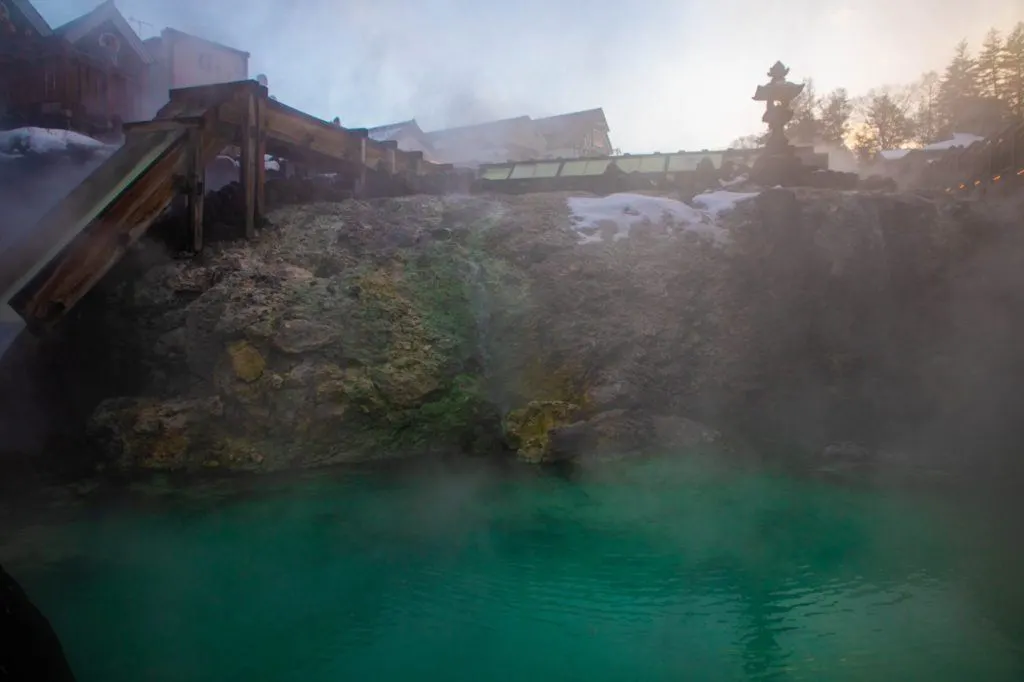
Mountains, volcanoes really, are one of the things that Japan is known for. The volcanic country sits atop the Ring of Fire, and thanks to these volcanoes, the earth runs very hot underneath all that rock and snow. This makes it a perfect place to have hot springs.

What is Kusatsu Famous For?
Kusatsu is well-known for its hot springs, over 100 in the small city. The most famous of which is the one right downtown in the center, called Yubatake. People have come to Kusatsu for centuries to bathe in the healing sulphuric and mineral-rich waters.
“Kusatsu yoi toko, ichido wa o-ide…,”
“Kusatsu yoi toko, ichido wa o-ide…,” which in English means, “Come to Kusatsu once in your life, since it’s such a wonderful place.” (source)
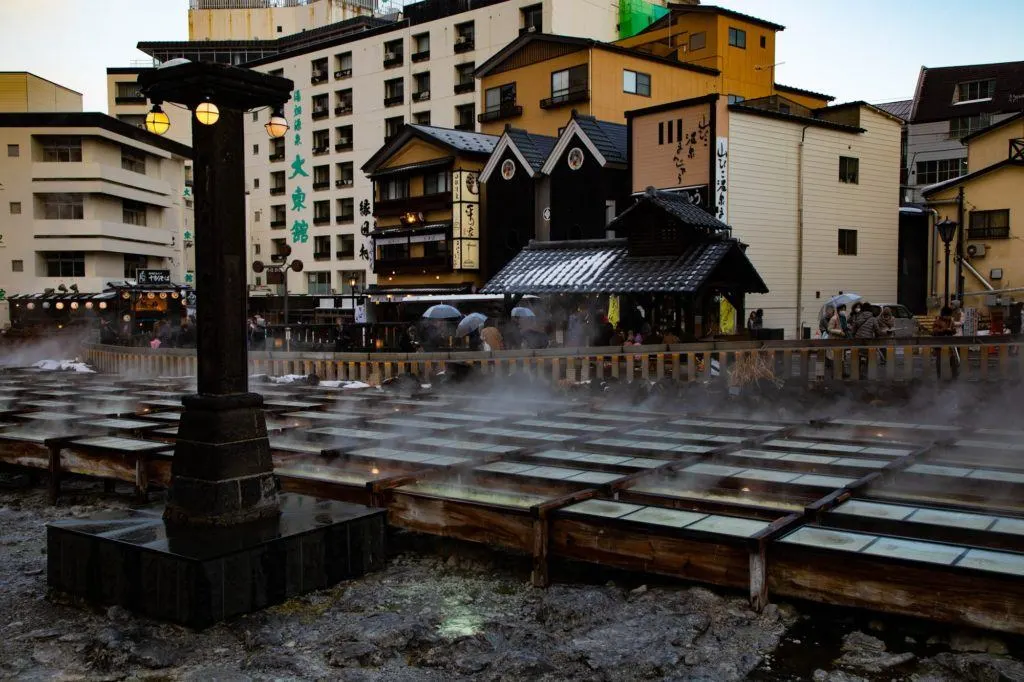
If you enjoy unique things you can only do in Japan, check out this podcast!
See the Yumomi
What is yumomi? It’s a traditional way to cool the very hot waters of Kusatsu so that people can bathe in it. The water found here can range from 51 – 94 degrees Centigrade, which is too hot for a human to endure, and adding cold water to it would change the chemical makeup, reducing the health benefits.
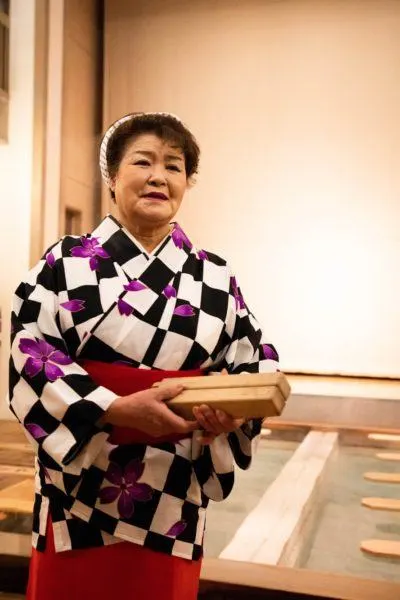
To combat these issues, it was discovered over 300 years ago, that using paddles to stir and splash the water would cool it more naturally, as well as softening the water making it easier to bathe in.

Today you can see a yumomi performance with women cooling the water as they sing folk songs. This is one of the highlights of things to do in Kusatsu. At the Netsu-no-yu, the public bathhouse has been turned into a theater where you can watch this performance many times per day.
Check out the Netsu-no-yu website for times and fees.

When is the Best Time to Go to Kusatsu Onsen?
The best time to go to Kusatsu is when you need a break from your work or everyday life. As an onsen town, the entire purpose is to make you feel better, improve your health. However, since you do this by sitting in hot springs, my favorite time of year to go is winter.

Other than the Sainokawara onsen, which is completely outdoors, all the onsen in Kusatsu have indoor facilities and if they have outdoors as well, it’s covered. So, even during the rainiest months of June, July, and August, you can go and enjoy yourself.

the minerals after the water has evaporated.
What to Do
The main thing to do in Kusatsu is to experience onsen after onsen, picking the best one to relax in. Onsen is unique to Japan, it’s completely different than even the other neighboring Asian countries. Some of the onsens we enjoyed included (in order of our recommendation):
- Goza-no-yu – Traditional onsen in the center of town
- Sai-no-Kawara Outdoor Bath – My favorite
- Otaki-no-yu – The best of the indoor onsens
- Public Bathhouses – 3 open to visitors
- Therme Therme – Easiest and most comfortable for westerners since swimwear is mandatory

Goza
Located right in the middle of the city, this is one of the oldest onsens in Kusatsu with people bathing here for over 1,000 years.
As you walk in, you will notice the beautiful wooden interior, which starts to relax you right away. The entryway has a small souvenir shop, some sitting areas, and snack and drink vending machines. So, don’t stay there too long, get on up the stairs to the dressing rooms.
There are two large baths in this onsen, very traditional and both completely indoors. The building is so close to the Yubatake, that the water, for me was way too hot.
When I visited the only people that stayed in the water for any length of time were hardened old ladies used to the boiling temperature.
I think everyone should visit this onsen, because of its history, however, it wasn’t my favorite.
Click on the Goza onsen website for hours and costs.

entrances to the dressing rooms, red for women and blue for men.
Sainokawara Outdoor Bath
The Sainokawara rotenburo (outdoor public bath) is about a 15 minute walk from the center of town. For me, though, it was by far my favorite.
We decided to go at night, because there’s just something about getting naked and being outside after the sun goes down, and the night we went the moon really put on a great show as well. It was perfect.
Most of the walk to get to the bath is through the Sainokawara Koen (park), which at night is illuminated with all colors of lights, which makes it fun, even romantic to stroll through.
Once you arrive, the entrance kiosk is outside of the changing rooms. The attendant took our money and pointed Jim his way and me mine. The changing rooms were pretty bare bones compared to the other onsens we visited. It had only a few shower stations, and the floor was a bit cold on the feet, but it just made you get out into the water faster.
Whether because of its location or the time of day, it also had the least amount of people in it. I think there were no more than 10 on either side at any time. This added to the overall enjoyment as well.
Whatever you do, if you love onsen, don’t miss this one. Visit the Sainokawara onsen website for fees and hours.

small hot spring pools along the paths, like this one.
Otaki Onsen
Otaki is a special onsen, one that again you should experience. What makes it so special is the long bath room with awase-yu baths.
Awase-yu, pretty rare to find, are a series of baths in a step down, or leveling down type of formation. Each bath rises in temperature, with the hottest at the bottom. The temperatures range from about 38 – 46 degrees Centigrade, which for me means I can only handle the first couple for any length of time.
In fact, I wasn’t the only one. The other women who were there when I was, giggled and dipped their toes in the lowest, hottest baths, but few entered. If they did, they certainly didn’t stay long. However, this bath is supposed to be the best for your skin, so the payoff would be worth it.
When you are tired of trying to sit in the hot pools, there are other baths that are perfect for lounging, as well as a combined relax and dressing room just for the ladies to hang out in. For me that was another first, usually the relax rooms are completely separate from the bathing areas.
At any rate, Otaki is a must-do. Other services it offers includes massages and such, but the best thing is the restaurant on site. We had their famous ice cream, which was a perfect snack for our red bodies.
Check out Otaki’s times and fees here.
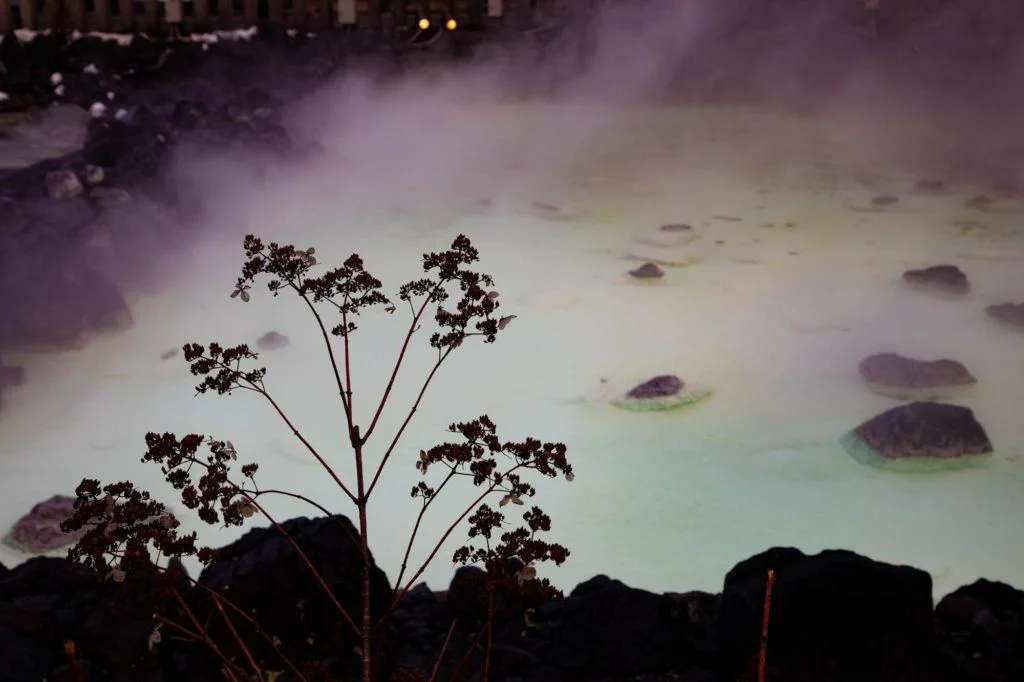
Public Bathhouses
These onsens are completely authentic. They are not meant for tourists or visitors, they are for the locals to bathe, and because of this they are very small and have virtually no amenities. However, to get a real look into local public bathhouses, I would recommend visiting one.
There are only three of the 19 public bathhouses open to the public, and they are Shirahata, Chiyo, and Jizo. Make sure to ask your hotel when they are open to visitors, and don’t forget to take your hygiene products and towels with you as they will not be provided.
Therme Therme
If you go to Kusatsu with a family or you are not really up to the full traditional, get naked, kind of experience, you can always go to Therme Therme. It’s really an indoor pool with various play areas. It’s part of the larger resort called Hotel Village about 15 minutes from the center of Kusatsu.
Public Bath or Onsen Etiquette
- Bring a small basket with your hygiene needs. Usually body wash, shampoo, and conditioner are provided in the larger onsens. You can sometimes rent a towel, but bringing a small one is a good idea.
- Sitting on small stools in the shower area, completely and thoroughly wash your body before entering the pools.
- When in the pools, do not let your small towel enter the water.
- If your small towel does get wet, don’t wring it out into the bath.
- Speak softly and quietly if you are with someone.
- When finished, pat dry with your small towel before re-entering the dressing area.

Where to Eat
There are plenty of restaurants in Kusatsu as it’s a place for visitors. Many of the ryokans will offer just breakfast, or breakfast and dinner. It’s an easy way to travel, so you don’t have to worry about where you are going to eat, but of course you have no choice as to the menu.
While we were there we tried a few different restaurants:
- Yasuragi – Soba
- Donguri – Japanese and Western
- Garden – Western food
- Italo – Pizza and pasta
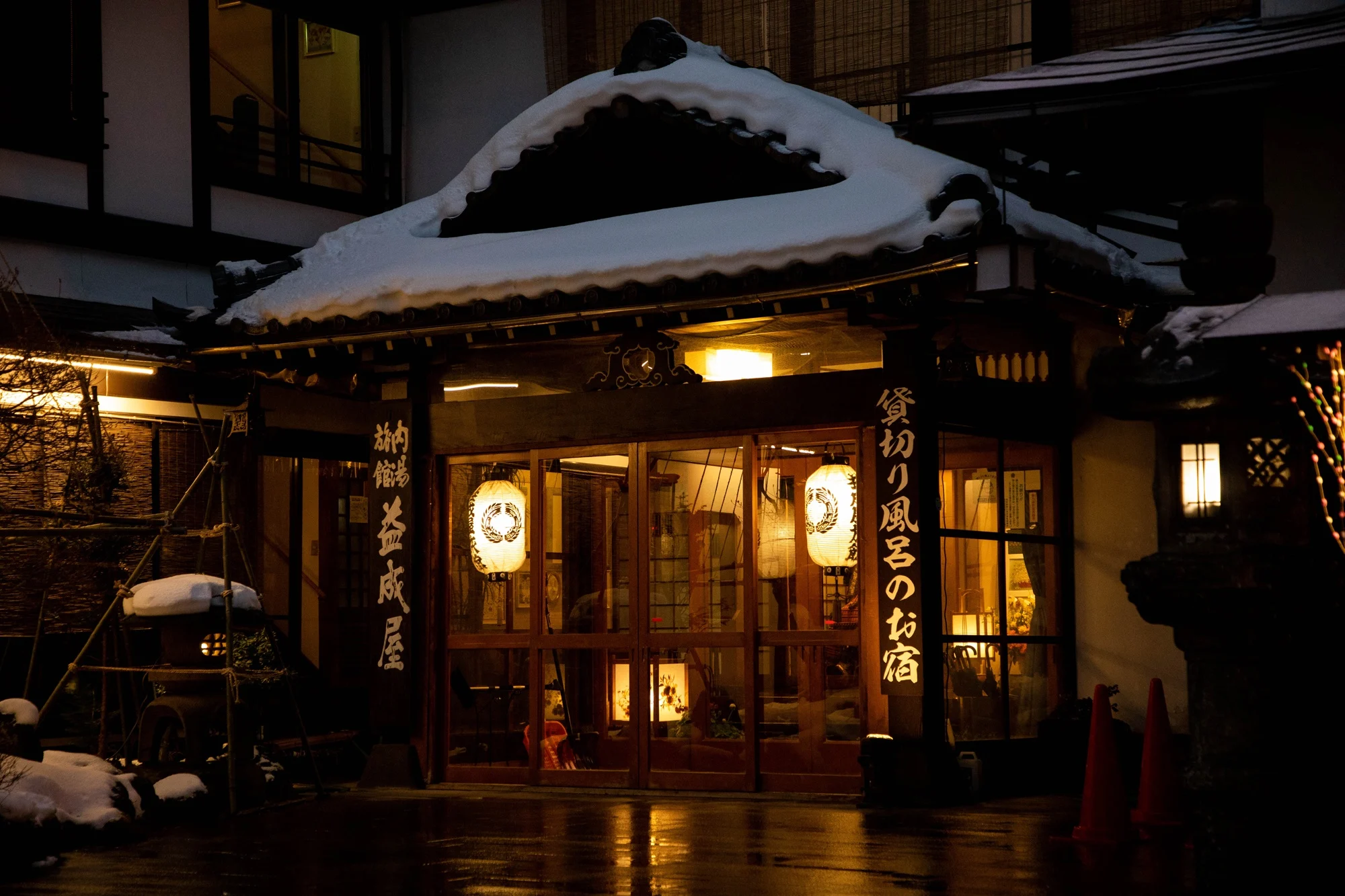
Where to Stay
Most people stay in one of the many traditional ryokans while in Kusatsu. You can stay in a smaller hotel or a more traditional one, but no matter what every hotel will offer you yuukata and onsen baskets to take around town.
How to Get to Kusatsu
Kusatsu is well connected to to public transportation and easily accessible by car. Self driving in Japan is very rewarding and much easier than most tourists imagine. Just remember, if you are driving yourself, make sure your hotel has parking and if traveling in winter, have snow chains and know how to use them.
How to Get There from Tokyo
Train Option 1: Starting at the Omiya Stations, take the Akagi Limited Express Kusatsu 3 towards Naganohara-Kusatsuguchi. This leaves a few times per day and takes about 2 hours. From Naganohara, take Kusatsu Onsen bus, which will take an additional 25 minutes.
Train Option 2: Start at Ueno station and take the Limited Express to Nagano-Kusastsuguchi (about 2 1/2 hours), then take the bus to Kusatsu.
Bus Option: Start at the Shinjuku Nishi-guchi bus station and take the Expressway bus to Kusatsu Onsen. This takes about 4 hours, but is also half the cost of the train with no transfers.
How to Get There from Nagano
From Nagano station take the Hokuriku-Shinkansen Hakutaka Hakutaka 560 towards Tokyo. Change trains in Takasaki to the Akagi Limited Express towards Naganohara-Kusatsuguchi, where you’ll get on the bus to Kusatsu. This takes about 1 1/2 hours.

Things to do Nearby
Kusatsu is pretty isolated in a lot of ways, so the term “nearby” is relative. We’ve listed things to do that you might want to add to your itinerary before or after your visit.
- Snow Monkeys (2 hours by car)
- Nagano (see above)
- Nikko (3 hours)
- Matsumoto (2 hours)
Conclusion
If you are either traveling in Japan during the cold winter, or just looking to have a relaxing couple of days in a truly traditional town, you really should make your way to Kusatsu Onsen. The soothing hot springs will calm you, body and soul.
Author Bio: Corinne Vail is a travel photographer, food lover, and a perpetual traveler who has been travel writing for over 14 years. For many years she lived overseas in Germany, Japan, Turkey, South Korea, and the Netherlands teaching the children of the US. military. She’s visited over 90 countries, and she’s not stopping anytime soon.


Phoebe
Thursday 6th of February 2020
I'm really ignorant when it comes to Japanese culture and onsens have confused me but you lay it all out so clearly I can now picture what to expect and would LOVE to experience one! Especially in the snow too. Just my kind of thing.
Corinne Vail
Thursday 6th of February 2020
Phoebe, It is a little daunting to try onsen for the first time, but it quickly becomes addicting! LOL